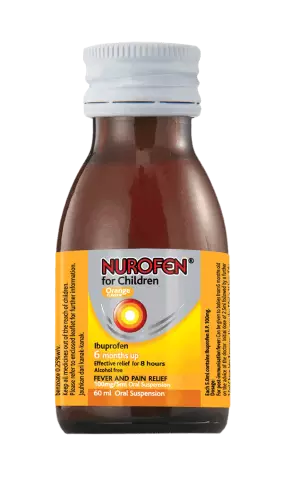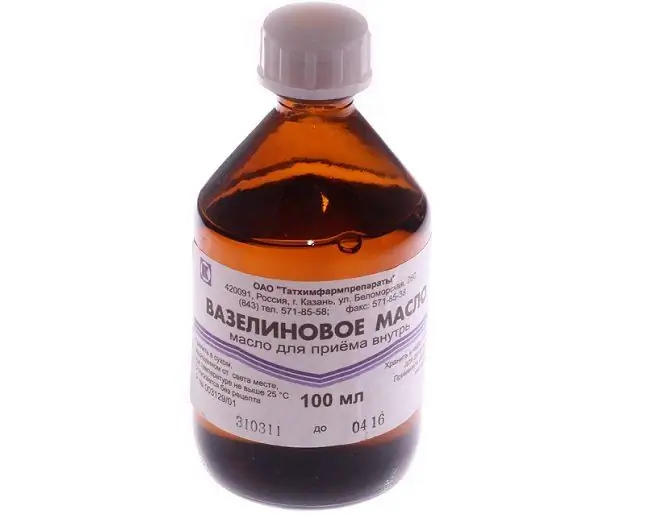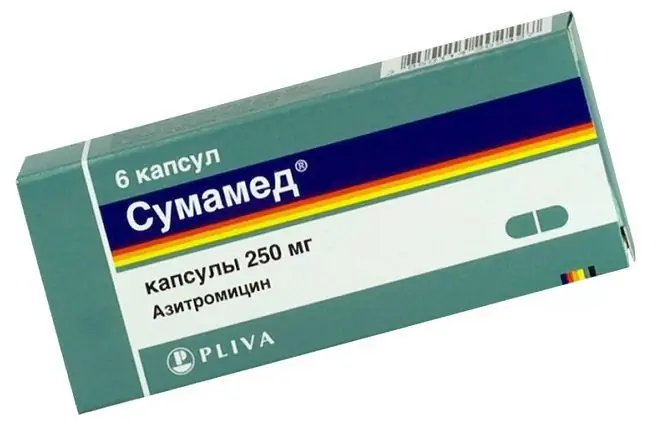- Author Rachel Wainwright [email protected].
- Public 2023-12-15 07:39.
- Last modified 2025-11-02 20:14.
Nurofen for children
Nurofen for children: instructions for use and reviews
- 1. Release form and composition
- 2. Pharmacological properties
- 3. Indications for use
- 4. Contraindications
- 5. Method of application and dosage
- 6. Side effects
- 7. Overdose
- 8. Special instructions
- 9. Application during pregnancy and lactation
- 10. Use in childhood
- 11. In case of impaired renal function
- 12. For violations of liver function
- 13. Use in the elderly
- 14. Drug interactions
- 15. Analogs
- 16. Terms and conditions of storage
- 17. Terms of dispensing from pharmacies
- 18. Reviews
- 19. Price in pharmacies
Latin name: Nurofen for Children
ATX code: M01AE01
Active ingredient: Ibuprofen (Ibuprofen)
Manufacturer: Reckitt Benckiser Healthcare International Ltd. (United Kingdom)
Description and photo update: 2018-22-10
Prices in pharmacies: from 95 rubles.
Buy

Nurofen for children is an NSAID (non-steroidal anti-inflammatory drug) used in pediatric practice.
Release form and composition
Nurofen dosage forms for children:
- coated tablets: biconvex, round, Nurofen inscription is printed on one side in black, the shell and core are white to almost white in cross section (6, 8, 10 or 12 pcs. in blisters, 1 or 2 blisters in a pack of cardboard; 10 or 12 pcs. in blisters, 3 blisters in a pack of cardboard; 12 pcs. in blisters, 4 or 8 blisters in a pack of cardboard);
- suspension for oral administration (orange / strawberry): a liquid of syrupy consistency, from white to almost white, with a characteristic orange / strawberry odor (100, 150 or 200 ml each in polyethylene terephthalate bottles, equipped with a syringe dispenser, 1 set in a cardboard box);
- rectal suppositories: torpedo-shaped, glossy, from white to almost white; it is allowed to have a funnel-shaped recess or an air rod on the cut (5 pcs. in aluminum blisters, 2 blisters in a cardboard box).
Composition for 1 tablet:
- active substance: ibuprofen - 200 mg;
- auxiliary ingredients: sodium lauryl sulfate, sodium citrate dihydrate, croscarmellose sodium, stearic acid, colloidal silicon dioxide;
- shell: sodium carmellose, acacia gum, titanium dioxide, sucrose, macrogol 6000, talc;
- black ink Opakod S-1-277001: shellac, iron dye black oxide (E172), propylene glycol and solvents that evaporate during the printing process (butanol, ethanol, isopropanol, purified water).
Composition for 5 ml of suspension:
- active substance: ibuprofen - 100 mg;
- auxiliary ingredients: maltitol syrup, glycerol, polysorbate 80, sodium saccharinate, sodium chloride, sodium citrate, citric acid, xanthan gum, orange flavor 2M16014 / strawberry 500244E, domiphene bromide, purified water.
Composition for 1 suppository:
- active substance: ibuprofen - 60 mg;
- auxiliary ingredients: solid fats - witepsol H15 and witepsol W45.
Pharmacological properties
Pharmacodynamics
The active ingredient of Nurofen for children is ibuprofen. Like other non-steroidal anti-inflammatory drugs, it deliberately relieves pain symptoms, has anti-inflammatory and antipyretic effects.
As a non-selective blocker, ibuprofen blocks cyclooxygenase 1 and 2 (COX-1 and COX-2), which inhibits the synthesis of mediators of inflammation, pain and hyperthermic reaction - prostaglandins. In addition, ibuprofen reversibly inhibits platelet aggregation.
The drug has the most pronounced analgesic effect in pain of inflammatory genesis; its effect lasts for 8 hours.
Pharmacokinetics
- absorption and distribution: ibuprofen is well absorbed in the gastrointestinal tract (gastrointestinal tract), rapidly and almost completely absorbed into the systemic circulation. In blood plasma after taking on an empty stomach, the substance is detected after 15 minutes, and the maximum plasma concentration (C max) is reached after 60 minutes. Taking the drug with food can increase the time to reach C max up to 120 minutes. Up to 90% of ibuprofen binds to blood plasma proteins, as a result of which the substance, slowly penetrating into the cavities of the joints, is retained for a long time in the synovial fluid, providing in it concentrations higher than in plasma. In breast milk, according to a few studies, ibuprofen penetrates in extremely low concentrations;
- metabolism and excretion: up to 60% of the substance in the pharmacologically inactive R-form after absorption is slowly transformed into the active S-form; Ibuprofen is metabolized in the liver; excreted by the kidneys (only less than 1% unchanged), to a lesser extent - with bile. The half-life of the drug is 2 hours.
Indications for use
Nurofen for children, depending on the dosage form, is used to treat patients of different age groups: suppositories are prescribed for children from 3 months to 2 years old, suspension - for children from 3 months to 12 years old, tablets - for children from 6 years old and adult patients. Nurofen suppositories for children are also advised to be used if for some reason it is impossible to take oral forms of the drug, or in case of vomiting.
All forms of release of the drug are used as an analgesic for relieving pain of various origins: headache, toothache, ear pain, sore throat, muscle, menstrual, articular, rheumatic, back pain, neuralgia, migraines and other pathological conditions accompanied by pain syndrome.
As an antipyretic agent, Nurofen for children is recommended for the following infectious and inflammatory diseases and conditions accompanied by fever: ARI (acute respiratory diseases), influenza, childhood and other infections, post-vaccination reactions.
Nurofen for children is intended only for symptomatic therapy, relieving pain and relieving inflammation at the time of its use. The drug has no clinically significant effect on disease progression.
Contraindications
Absolute contraindications to the use of Nurofen for children in any form of release:
- erosive and ulcerative lesions of the gastrointestinal tract in the acute phase, including ulcerative colitis, peptic ulcer, exacerbation of gastric ulcer and 12 duodenal ulcer, Crohn's disease (including data in history);
- severe arterial hypertension;
- the period after CABG (coronary artery bypass grafting);
- decompensated heart failure;
- syndrome of complete or incomplete aspirin intolerance (urticaria, polyps of the nasal mucosa, rhinosinusitis, bronchial asthma) and / or other NSAIDs;
- blood diseases (hemophilia, other clotting disorders, hemorrhagic diathesis, glucose-6-phosphate dehydrogenase deficiency, hypocoagulation);
- severe liver dysfunction;
- severe renal dysfunction with creatinine clearance (CC) <30 ml / min;
- bleeding (intracranial, from the gastrointestinal tract, etc.);
- III trimester of pregnancy;
- increased individual sensitivity to the active substance or any other components of the drug.
Additional contraindications for tablets:
- diseases of the optic nerve (scotoma, amblyopia, color vision disorders);
- hearing loss, violation of the vestibular apparatus;
- breast-feeding;
- age up to 6 years.
Additional contraindications for the suspension:
- intolerance to fructose;
- confirmed hyperkalemia;
- child's weight up to 5 kg.
Additional contraindications for suppositories:
- proctitis;
- confirmed hyperkalemia;
- child's weight up to 6 kg.
Relative contraindications for the use of Nurofen for children (caution is required): simultaneous use with other NSAIDs, history of gastric ulcer, gastrointestinal ulcer bleeding, enteritis, gastritis, colitis, Helicobacter pylori infection, ulcerative colitis; bronchial asthma or allergic diseases in the stage of exacerbation, or data on such in the anamnesis (probably the development of bronchospasm), severe somatic diseases, systemic lupus erythematosus or mixed connective tissue disease, the so-called. Sharp's syndrome (the likelihood of aseptic meningitis increases), renal failure, including dehydration (with a CC of 30-60 ml / min), fluid retention and edema; liver failure, arterial hypertension / heart failure, diabetes mellitus, cerebrovascular diseases,hyperlipidemia / dyslipidemia, peripheral arterial disease, blood diseases of unknown etiology (anemia, leukopenia), simultaneous use with other drugs that can increase the likelihood of ulceration or bleeding, namely with oral corticosteroids (glucocorticosteroids) (including prednisolone), anticoagulants (including warfarin), selective serotonin reuptake inhibitors (including fluoxetine, paroxetine, citalopram, sertraline), antiplatelet agents [including acetylsalicylic acid (ASA) and clopidogrel]; I and II trimesters of pregnancy, advanced age; breastfeeding period - for suspension and suppositories; children from 6 to 12 years old - for tablets.simultaneous use with other drugs that can increase the likelihood of ulceration or bleeding, namely with oral corticosteroids (glucocorticosteroids) (including prednisolone), anticoagulants (including warfarin), selective serotonin reuptake inhibitors (including fluoxetine, paroxetine, citalopram, sertraline), antiplatelet agents [including acetylsalicylic acid (ASA) and clopidogrel]; I and II trimesters of pregnancy, advanced age; breastfeeding period - for suspension and suppositories; children from 6 to 12 years old - for tablets.simultaneous use with other drugs that can increase the likelihood of ulceration or bleeding, namely with oral corticosteroids (glucocorticosteroids) (including prednisolone), anticoagulants (including warfarin), selective serotonin reuptake inhibitors (including fluoxetine, paroxetine, citalopram, sertraline), antiplatelet agents [including acetylsalicylic acid (ASA) and clopidogrel]; I and II trimesters of pregnancy, advanced age; breastfeeding period - for suspension and suppositories; children from 6 to 12 years old - for tablets.selective serotonin reuptake inhibitors (including fluoxetine, paroxetine, citalopram, sertraline), antiplatelet agents [including acetylsalicylic acid (ASA) and clopidogrel]; I and II trimesters of pregnancy, advanced age; breastfeeding period - for suspension and suppositories; children from 6 to 12 years old - for tablets.selective serotonin reuptake inhibitors (including fluoxetine, paroxetine, citalopram, sertraline), antiplatelet agents [including acetylsalicylic acid (ASA) and clopidogrel]; I and II trimesters of pregnancy, advanced age; breastfeeding period - for suspension and suppositories; children from 6 to 12 years old - for tablets.
Nurofen instructions for use for children: method and dosage
Film-coated tablets
The tablets are taken orally, after a meal, washed down with water.
The recommended dosage of Nurofen for children over 12 years of age and adults, if there are no other doctor's prescriptions: 200 mg (1 tablet) 3-4 times a day. If it is necessary to achieve a faster therapeutic effect for adult patients, the dose can be increased to 400 mg (2 tablets) 3 times a day.
Children aged 6 to 12 years, weighing more than 20 kg, are recommended to take 1 tablet up to 4 times a day.
The interval between doses of the drug should not be less than 6 hours.
The maximum daily dose is 1200 mg (6 tablets).
If the symptoms of the disease persist after taking the pills for 2-3 days, it is necessary to interrupt therapy and seek medical advice.
Oral suspension
The suspension is intended for oral administration. With increased sensitivity of the gastrointestinal tract, it is recommended to combine taking the drug with food. Before use, the suspension bottle should be shaken thoroughly.
The maximum daily dose for the treatment of fever and pain syndrome should not exceed 30 mg / kg of the child's weight, and the intervals between doses should not be less than 6-8 hours.
Recommended dosage of Nurofen for children, depending on the age and weight of the child:
- children from 3 to 6 months, weighing 5-7.6 kg: 50 mg (2.5 ml) 3 times a day; daily dose - 150 mg (7.5 ml);
- children from 6 to 12 months, weighing 7.7-9 kg: 50 mg (2.5 ml) 3-4 times a day; daily dose - 200 mg (10 ml);
- children from 1 to 3 years old, weighing 10-16 kg: 100 mg (5 ml) 3 times a day; daily dose - 300 mg (15 ml);
- children from 4 to 6 years old, weighing 17-20 kg: 150 mg (7.5 ml) 3 times a day; daily dose - 450 mg (22.5 ml);
- children from 7 to 9 years old, weighing 21-30 kg: 200 mg (10 ml) 3 times a day; daily dose - 600 mg (30 ml);
- children from 10 to 12 years old, weighing 31-40 kg: 300 mg (15 ml) 3 times a day; the daily dose is 900 mg (45 ml).
The duration of therapy should not exceed 3 days. The specified dose should not be exceeded.
If the symptoms of the disease persist after taking the suspension throughout the day in children aged 3-5 months, or three days in children aged six months and older, or if they increase, treatment should be discontinued and consult a doctor.
For relief of fever after immunization, children under the age of six months are given a single dose of ibuprofen - 50 mg (2.5 ml of suspension); if necessary, after 6 hours, you can prescribe a second dose at the same dose.
The maximum daily dose of Nurofen for children is 100 mg (5 ml).
The exact dose of the suspension is measured using a measuring syringe attached to the bottle (1 ml of the suspension contains 20 mg of ibuprofen, respectively, 5 ml - 100 mg).
Rules for using a measuring syringe:
- The syringe is tightly inserted into the neck of the bottle.
- The vial with the inserted syringe is turned upside down, the piston is smoothly pulled downward, picking up the suspension to the required mark.
- The bottle is returned to its original position, after which the syringe is carefully turned and removed.
- The syringe is placed in the child's oral cavity, the plunger is slowly pressed, gradually releasing the suspension.
- After the procedure, the syringe is washed with warm water and dried out of the reach of children.
Rectal suppositories
Nurofen Suppositories for Children are intended for rectal administration.
When treating fever and pain, the dose is calculated based on the child's age and weight. The maximum daily dose should not be more than 30 mg / kg of the child's weight, and the intervals between doses should not be less than 6-8 hours.
The recommended dose of the drug, depending on the age and weight of the child:
- children from 3 to 9 months, weighing 6-8 kg: 1 suppository (60 mg) up to 3 times a day; the maximum daily dose is 180 mg;
- children from 9 to 24 months, weighing 8-12 kg: 1 suppository (60 mg) up to 4 times a day; the maximum daily dose is 240 mg.
The duration of therapy should not exceed 3 days. The specified dose should not be exceeded.
If the symptoms of the disease persist after the use of suppositories throughout the day in children aged 3-5 months, or 3 days in children aged six months and older, or if they increase, treatment should be stopped and consult a doctor.
For relief of fever after immunization, children under the age of one year are prescribed a single administration of 1 suppository (60 mg); if necessary, after 6 hours, you can re-enter the drug in the same dose. More than 2 pcs. (120 mg) should not be used within 24 hours.
Side effects
The likelihood of side effects is reduced to a minimum, if the dosage regimen of Nurofen for children is observed and the use of ibuprofen in the shortest possible course in the minimum effective dose necessary to eliminate the symptoms of the disease.
Side effects recorded with short-term administration of ibuprofen in doses not exceeding 1200 mg per day, mainly dose-dependent (rating scale: very often - ≥ 0.1; often - ≥ 0.01 and <0.1; infrequently - ≥ 0.001 and < 0.01; rarely - ≥ 0.0001 and <0.001; extremely rare - <0.0001; with an unclear frequency - not enough data to conduct an assessment):
- hematopoietic system: extremely rarely - violations of hematopoiesis (leukopenia, anemia, aplastic / hemolytic anemia, pancytopenia, thrombocytopenia, agranulocytosis; the primary signs of such disorders are sore throat, fever, superficial ulcers in the oral cavity, severe weakness, subcutaneous hemorrhage symptoms, bleeding from the nose, bleeding and bruising of unexplained origin);
- immune system: infrequently - nonspecific allergic and anaphylactic reactions, responses from the respiratory tract (bronchial asthma, including its aggravation, shortness of breath, dyspnea, bronchospasm), skin reactions (urticaria, pruritus, purpura, Quincke's edema, exfoliative / bullous dermatoses, including toxic epidermal necrolysis, Stevens-Johnson syndrome, Lyell's syndrome, erythema multiforme), eosinophilia, allergic rhinitis; extremely rarely - severe hypersensitivity reactions (including swelling of the tongue, larynx and face), shortness of breath, arterial hypotension, tachycardia (anaphylaxis, Quincke's edema or severe anaphylactic shock);
- Gastrointestinal tract: infrequently - nausea, abdominal pain, dyspepsia; rarely - flatulence, constipation / diarrhea, vomiting; extremely rare - melena, peptic ulcer, gastritis, bloody vomiting, perforation or gastrointestinal bleeding, ulcerative stomatitis; with an unclear frequency - exacerbation of ulcerative colitis, Crohn's disease;
- liver and biliary tract: extremely rare - hepatic dysfunction;
- urinary system: extremely rarely - acute renal failure (compensated / decompensated), especially in the case of prolonged use, in combination with an increase in plasma urea and edema, papillary necrosis;
- nervous system: infrequently - headache; extremely rare - aseptic meningitis (mainly in patients with autoimmune diseases);
- cardiovascular system: with an unclear frequency - peripheral edema, heart failure, increased blood pressure, with prolonged use increases the likelihood of thrombotic complications (myocardial infarction, stroke);
- respiratory system: with an unclear frequency - bronchospasm, shortness of breath, bronchial asthma;
- other reactions: extremely rarely - edema, including peripheral;
- laboratory results: hematocrit / hemoglobin, plasma glucose concentration, CC (creatinine clearance) may decrease; plasma concentration of creatinine, activity of liver enzymes and bleeding time - increase.
In case of any side effects, drug therapy must be discontinued and consult a specialist.
As a result of the therapy of chronic conditions and during prolonged treatment, other adverse reactions may appear.
Overdose
In childhood, the onset of an overdose is possible after taking ibuprofen in a dose exceeding 400 mg / kg of the child's weight. The dose-dependent effect of the condition in adult patients is less pronounced. T 1/2 of a substance from the body is 1.5 to 3 hours.
Symptoms of an ibuprofen overdose are nausea / vomiting, epigastric pain, less often diarrhea, headache, tinnitus, gastrointestinal bleeding. In more severe cases, there are reactions from the central nervous system such as drowsiness, in rare cases - convulsions, agitation, disorientation, coma. As a result of severe poisoning, damage to the liver parenchyma, a decrease in blood pressure, cyanosis and respiratory depression, an increase in prothrombin time, the development of metabolic acidosis, and renal failure are possible. With bronchial asthma, its aggravation is possible.
Treatment is recommended to be symptomatic, under the control of airway patency, electrocardiogram data and basic vital signs of the patient, up to the normalization of his condition. Within an hour after taking a potentially dangerous dose of ibuprofen, it is required to give the patient activated charcoal or to wash the stomach. With the complete absorption of ibuprofen into the systemic circulation, the patient needs an alkaline drink to remove the acidic ibuprofen derivative by the kidneys and conduct forced diuresis. Frequent and / or prolonged convulsions are controlled by intravenous diazepam or lorazepam. Aggravation of bronchial asthma requires the use of bronchodilators.
special instructions
Nurofen for children should be used in the shortest possible course, in the lowest dose effective to eliminate symptoms.
During prolonged therapy, it is required to monitor the peripheral blood picture and the functional state of the liver and kidneys.
In the event of symptoms of gastropathy, careful monitoring of the patient's condition is necessary, including esophagogastroduodenoscopy, complete blood count (including determination of hemoglobin) and fecal occult blood test.
On the eve of the determination of 17-ketosteroids, 48 hours before the study, the use of ibuprofen is temporarily stopped.
Taking ethanol during drug therapy should be avoided.
Nurofen for children in the form of a suspension for oral administration is contraindicated in patients with fructose intolerance, since it contains maltitol.
For children with diabetes mellitus, the suspension is approved for use, since it does not contain sugar.
Nurofen for children does not contain dyes.
In case of renal failure, before using the drug, it is required to consult a doctor because of the likelihood of deterioration in the functional state of the kidneys due to the use of ibuprofen.
The drug can cause fluid retention in the body, swelling and an increase in blood pressure, therefore, with arterial hypertension (including a history of) and chronic heart failure, you should consult a specialist before using the drug.
Influence on the ability to drive vehicles and complex mechanisms
If, as a result of taking ibuprofen, side reactions such as drowsiness, lethargy, dizziness, blurred vision, driving vehicles or controlling complex mechanisms should be abandoned during the course of therapy.
Application during pregnancy and lactation
The appointment of Nurofen for children for pregnant women in the third trimester is contraindicated. The drug should be used in the I and II trimesters or during lactation (breastfeeding) only after the permission of the doctor.
There is evidence that ibuprofen can pass into breast milk in small quantities without clinically significant adverse effects on the health of a nursing infant.
Pediatric use
According to the instructions, Nurofen for children is used in childhood according to indications.
Suspension and suppositories are contraindicated for children up to 3 months of age, tablets - up to 6 years; the child's weight must be more than 5 kg - for suspension, more than 6 kg - for suppositories, more than 20 kg - for tablets.
With impaired renal function
The use of the drug is contraindicated in severe renal failure with CC less than 30 ml / min. Ibuprofen is prescribed with caution for renal failure with a CC of 30-60 ml / min, including with dehydration, fluid retention and swelling.
For violations of liver function
The use of Nurofen for children with severe hepatic insufficiency and liver diseases in the active phase is contraindicated.
Use in the elderly
Elderly patients should be prescribed the drug with caution.
Drug interactions
Medicines, the simultaneous use of which with ibuprofen should be avoided:
- ASA (with the exception of taking low doses, not more than 75 mg / day, prescribed by a doctor): combined use may increase the likelihood of adverse reactions; ibuprofen inhibits the anti-inflammatory and antiplatelet effect of aspirin (the incidence of acute coronary insufficiency may increase in patients receiving ASA in low doses as an antiplatelet agent after starting ibuprofen);
- other NSAIDs, including selective COX-2 inhibitors: it is not recommended to simultaneously use two or more drugs from the NSAID group due to the possible increase in the risk of side effects.
With caution, ibuprofen should be used concomitantly with the following drugs / preparations:
- anticoagulants (including warfarin) and thrombolytics: it is possible to increase their effectiveness;
- antihypertensive drugs [ACE (angiotensin converting enzyme) inhibitors and angiotensin II receptor antagonists], diuretics: their effectiveness may decrease and the nephrotoxicity of ibuprofen may increase in response;
- GCS: the likelihood of ulceration of the gastrointestinal tract mucosa and gastrointestinal bleeding increases;
- cardiac glycosides: possible aggravation of heart failure, a decrease in the glomerular filtration rate and an increase in the plasma concentration of cardiac glycosides;
- antiplatelet drugs and SSRIs (selective serotonin reuptake inhibitors): the risk of gastrointestinal bleeding increases;
- lithium preparations, methotrexate: an increase in the plasma concentration of these drugs is likely;
- mifepristone: since NSAIDs can reduce the effectiveness of mifepristone, they should be started 8-12 days (not earlier) after using mifepristone;
- cyclosporine, tacrolimus: the risk of nephrotoxicity increases;
- zidovudine: an increase in hematotoxicity is possible; it is reliably known about the increased risk of hemarthrosis and hematomas in HIV-positive patients with hemophilia, who received complex therapy with zidovudine and ibuprofen;
- quinolone antibiotics: the risk of seizures increases.
Analogs
Nurofen analogs for children are: Advil, Bonifen, Brufen SR, Deblok, Dolgit, Ibuprofen for children, Ibuprofen-Akrihin, Ibuprofen-Hemofarm, Ibufen, Maxikold, Faspik, MIG 400, MIG, Nurofen, Nurofen forte, Nebolofen, Express Sedalgin SPRINT, Solpaflex, Pedea and others.
Terms and conditions of storage
Store out of the reach of children at temperatures up to 25 ° C. Protect tablets and suppositories from moisture.
Shelf life: tablets, suspension - 3 years, suppositories - 2 years.
Terms of dispensing from pharmacies
Available without a prescription.
Reviews about Nurofen for children
Judging by the number of reviews, Nurofen for children is popular not only with parents and physicians, but also among young patients. Those who take the suspension note its pleasant taste. Among other advantages of the drug, its high efficiency, safety and ease of use are especially distinguished. The drug also attracts with a low age threshold, it can be used in children from 3 months of age.
As disadvantages, the presence of contraindications, the appearance of allergic reactions with prolonged use, and it is also noted that in some children, the drug does not bring down the high temperature immediately, but gradually.
Price for Nurofen for children in pharmacies
Approximate price of Nurofen for children, depending on the form of release and packaging: tablets, 8 pcs. in the package - 97 rubles, suppositories 10 pcs. in the package - 99 rubles, suspension with orange / strawberry flavor, 150 ml in a bottle - 175 rubles.
Nurofen for children: prices in online pharmacies
|
Drug name Price Pharmacy |
|
Nurofen for children 100 mg / 5 ml oral suspension strawberry (s) 100 ml 1 pc. RUB 95 Buy |
|
Nurofen for children suspension. for internal approx. strawberry 100mg / 5ml 100ml 108 RUB Buy |
|
Nurofen for children 100 mg / 5 ml oral suspension with orange flavor 100 ml 1 pc. 114 RUB Buy |
|
Nurofen for children 100 mg / 5 ml oral suspension strawberry (s) 150 ml 1 pc. 121 RUB Buy |
|
Nurofen for children 100 mg / 5 ml oral suspension with orange flavor 150 ml 1 pc. 142 RUB Buy |
|
Nurofen for children suspension. for internal approx. strawberry 100mg / 5ml 150ml 155 RUB Buy |
|
Nurofen for children suspension. for internal approx. orange 100mg / 5ml 150ml 161 r Buy |
|
Nurofen for children 100 mg / 5 ml suspension for oral administration with orange flavor 200 ml 1 pc. 182 r Buy |
|
Nurofen for children 100 mg / 5 ml oral suspension strawberry (s) 200 ml 1 pc. 184 r Buy |
|
Nurofen for children suspension. for internal approx. orange 100mg / 5ml 200ml 198 RUB Buy |
|
Nurofen for children suspension. for internal approx. strawberry 100mg / 5ml fl. 200ml 198 RUB Buy |
| See all offers from pharmacies |

Maria Kulkes Medical journalist About the author
Education: First Moscow State Medical University named after I. M. Sechenov, specialty "General Medicine".
Information about the drug is generalized, provided for informational purposes only and does not replace the official instructions. Self-medication is hazardous to health!






